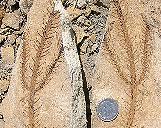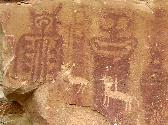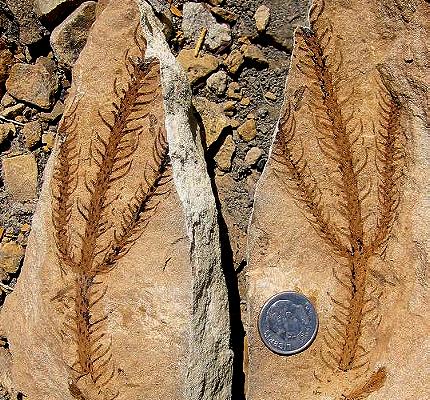
MANCOS SHALE |
The
Mancos Shale is the prevalent formation just north of I-70 in the eastern
portion of the state. Vast square miles of the Cretaceous shale are
visible from I-70 up to the base of the Book Cliffs to the north.
We walked a creekbed in the Mancos, but our finds were limited to some
poorly-preserved & unidentified clams and other invertebrates.
See "Mancos
Shale" for more images.
|

MESA VERDE GROUP |
As
you head further north on dirt roads, the Mancos mesas are capped with
sandstones of the Mesa Verde Group. Continuing further north into
canyons such as Middle Canyon or East Canyon, you enter the complex Mesa
Verde Group. Based on preliminary research, we believe our 2nd excavation
locality on Middle Canyon Rd. is in either the Nelsen or Sego Sandstone
Formations. The bench quarry was 3-5 meters to the west of Middle
Canyon Rd and approx. 5-8 meters above the road on a distinct outcrop.
We immediately found many palm fronds here, then many specimens of Araucaria
(?) and other unidentified leaves. Little research or organized collecting
of fossil plants has been done in these formations of the Mesa Verde Group.
Most leaves or poorly preserved which makes identification nearly impossible.
And, unfortunately, species of Araucaria is very hard to differentiate.
However, we did find one well-preserved specimen which is now in the collections
at the Denver Museum of Nature & Science (DMNS). See "Mesa
Verde Group" for more images of our finds.
|

PETROGLYPHS IN MESA VERDE GROUP |
Before
we arrived at the fossil plant locality in the Mesa Verde Group, we traveled
on the Middle Canyon dirt road through a private ranch. Just north
of the ranch, we observed many petroglyphs in the sandstone canyons.
Most appear to be authentic petroglyphs, yet others have been altered by
more "recent" graffiti. See "Petroglyphs
in Mesa Verde Group".
|

OTHER IMAGES, MESA VERDE GROUP |
For
other images in the Mesa Verde Group, such as concretions and cliffs, see
"Other Images".
|



